Exploring the world of online learning opens up exciting opportunities for both students and their parents. Essential to the process and success of digital learning is the mastery of effective note-taking—a skill that enhances comprehension, memorization, and long-term retention. Research has shown that students who take notes can perform up to 34% better on recall tests compared to those who do not.
This guide is designed to help parents/guardians understand the variety of note-taking techniques available and how they can support their students in identifying the best note-taking method suited to their individual learning style.
Understanding the importance of effective note-taking
At its core, note-taking is a critical thinking exercise that goes beyond mere transcription. It involves summarizing complex topics, jotting down key points, and organizing thoughts in a clear structure.
For students attending courses virtually, developing an online learning routine that includes good study habits is crucial, and good notes are an indispensable part of that routine. They serve as a reliable record of information, enabling students to review and internalize important points efficiently. By encouraging your student to develop strong note-taking skills, you’re empowering them with the ability to distill and retain valuable knowledge.
Universal note-taking skills for every learning style
Regardless of the specific technique your student adopts, there are several universal skills for effective note-taking:
- Selectivity: Teach your student to identify and jot down main points and essential concepts, rather than attempting to capture every word.
- Shorthand writing: Share time-management skills such as using abbreviations and symbols for faster note-taking during live, fast-paced lectures. Let students know that they can skip writing in complete sentences and instead jot down notes using their own words.
- Reviewing notes: Make reviewing notes a regular practice. Revisiting and revising notes helps to reinforce memorization and understanding, and translate into better academic performance.
- Visual elements: Introduce graphs, charts, and concept maps to make notes more engaging and easier to remember. Students can also use color-coding for organization, boxing in critical information for emphasis, and use arrows to highlight and connect key points.
Tailoring note-taking techniques to enhance learning
Finding the right note-taking technique is crucial for enhancing the learning experience. By tailoring these methods to fit individual preferences and different subjects, students can optimize their study sessions and improve information retention. Below are some helpful techniques to explore:
The Cornell method: structured and efficient
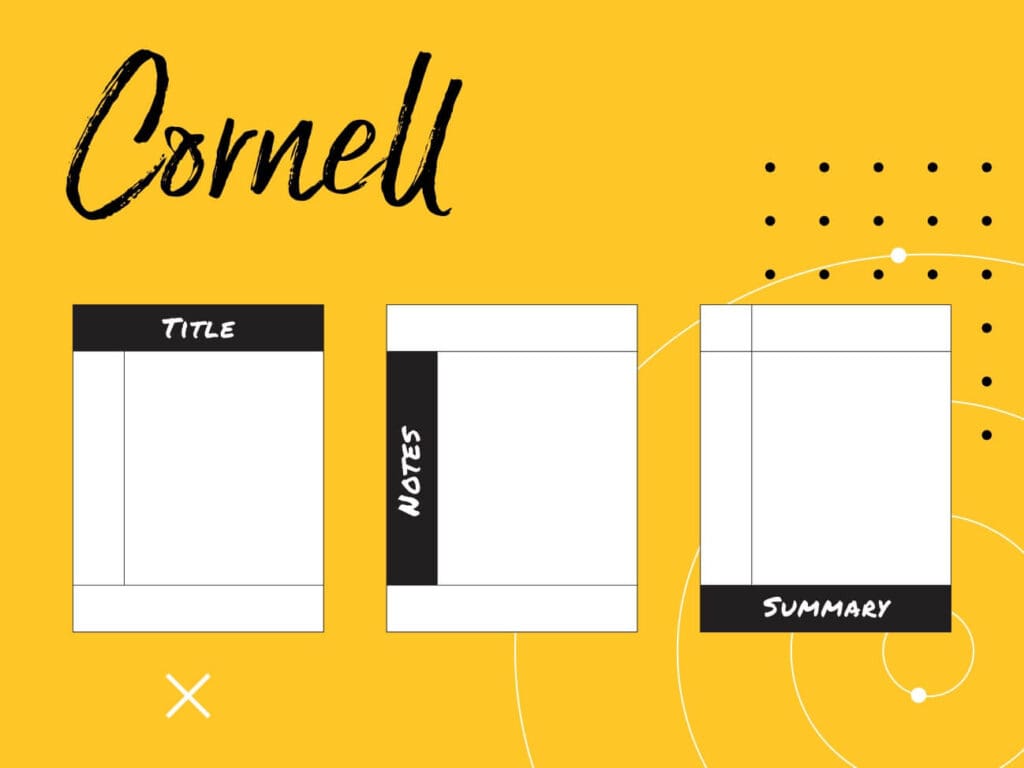
The Cornell method provides an easy-to-follow structure that encourages students to summarize their notes. By dividing their pages into sections, students can efficiently organize their thoughts and review material with ease.
To begin with, students divide their page into three distinct sections. The largest area is for detailed notes, a smaller column on the left is reserved for key points or cues, and a summary area at the bottom:
- Notes area: This section occupies about 70% of the page, typically on the right side. Here, students jot down comprehensive notes during lectures or while reading. The idea is to capture the essence of the information in a manner that can be easily understood when reviewed later.
- Cues area: The left column, which takes up about 30% of the page, is for keywords, questions, or brief statements. These cues are meant to trigger memory and encourage deeper thinking about the material. They should be written either during the lecture or immediately after when reviewing the notes.
- Summary area: At the bottom of the page, a section is dedicated to summarizing the entire page of notes in just a few sentences. This part is crucial as it forces the student to distill the essence of what they’ve learned, enhancing understanding and retention.
Implementing the Cornell method requires practice but becomes second nature over time. Students are encouraged to refine their approach based on what works best for them—perhaps by adjusting the size of sections or the way they identify key points.
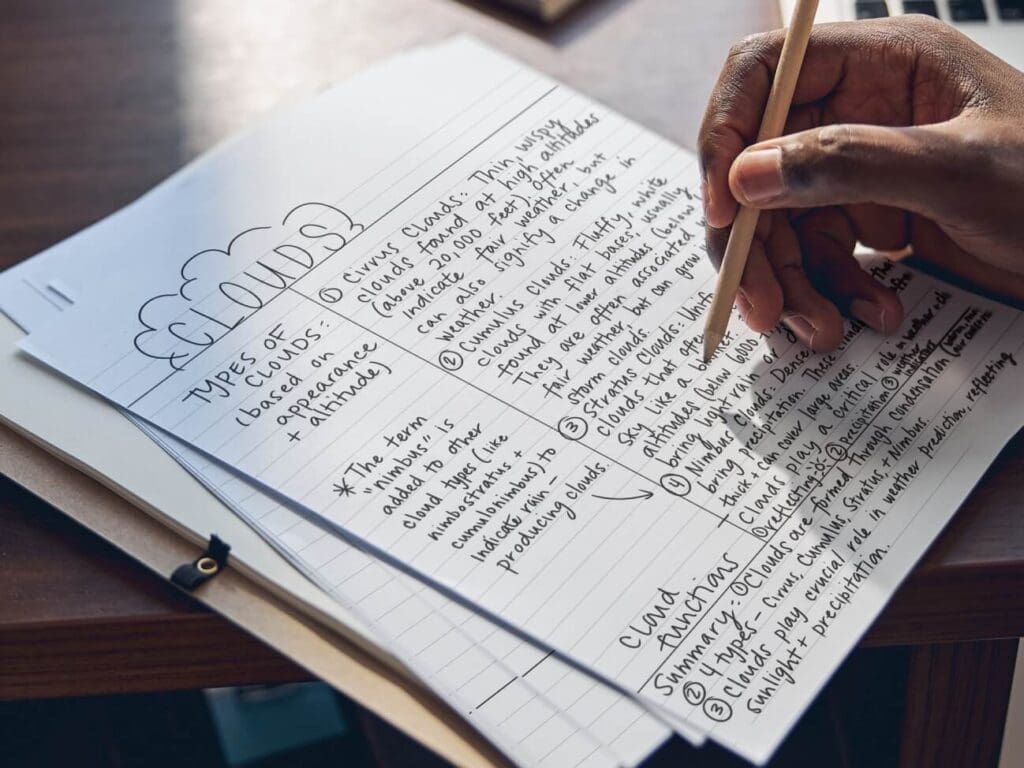
Mapping method and concept maps for visual learners
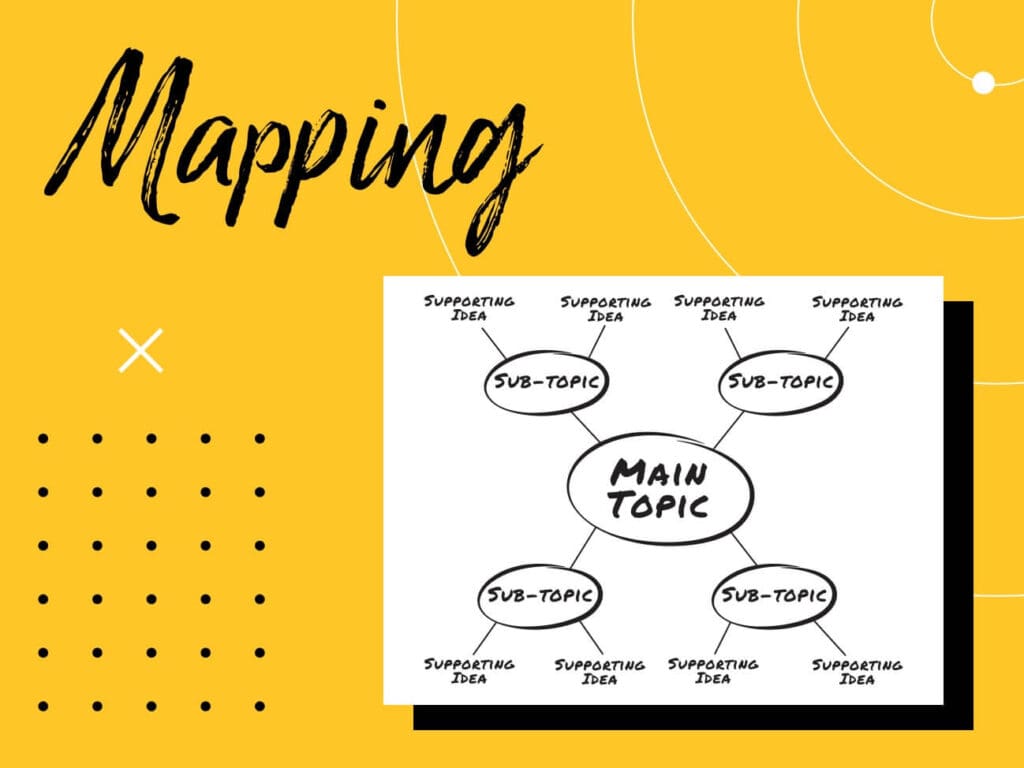
Mapping techniques, including the creation of concept maps, are ideal for visual learners. These methods allow students to visually explore connections between ideas, facilitating the understanding of complex topics. Encouraging your child to use mapping for brainstorming or when dealing with multifaceted subjects can significantly enhance their grasp of the material.
Here’s a step-by-step guide on how to effectively implement mapping techniques for note-taking or studying:
- Identify the key concept or topic: Start by determining the main idea or topic that will be the focus of your map. Place this concept at the center of your map.
- Break down major subtopics: From the central concept, draw branches out to smaller circles or nodes that represent major subtopics or key ideas related to the main topic.
- Add details and information: For each subtopic, add additional branches that break down the idea into more specific details or pieces of information. This could include definitions, examples, evidence, or other relevant data that supports the understanding of each subtopic.
- Highlight connections: Once you’ve added details to your map, look for connections between different subtopics or pieces of information. Draw lines or arrows to show these relationships, labeling them if necessary to explain the nature of the connection. This process can reveal new insights about how concepts interlink.
- Review and revise: After mapping out your ideas, take some time to review the map as a whole. Check if there are any areas that need further elaboration or if there are new connections you hadn’t considered initially. Updating your map to reflect a deeper understanding or to incorporate new information is a crucial part of the learning process.
Encouraging your child to use mapping techniques for note-taking and brainstorming provides them with a powerful tool for understanding complex subjects. By visually exploring and organizing information, they can develop a more comprehensive grasp of the material.

Charting and diagramming method for comparative analysis
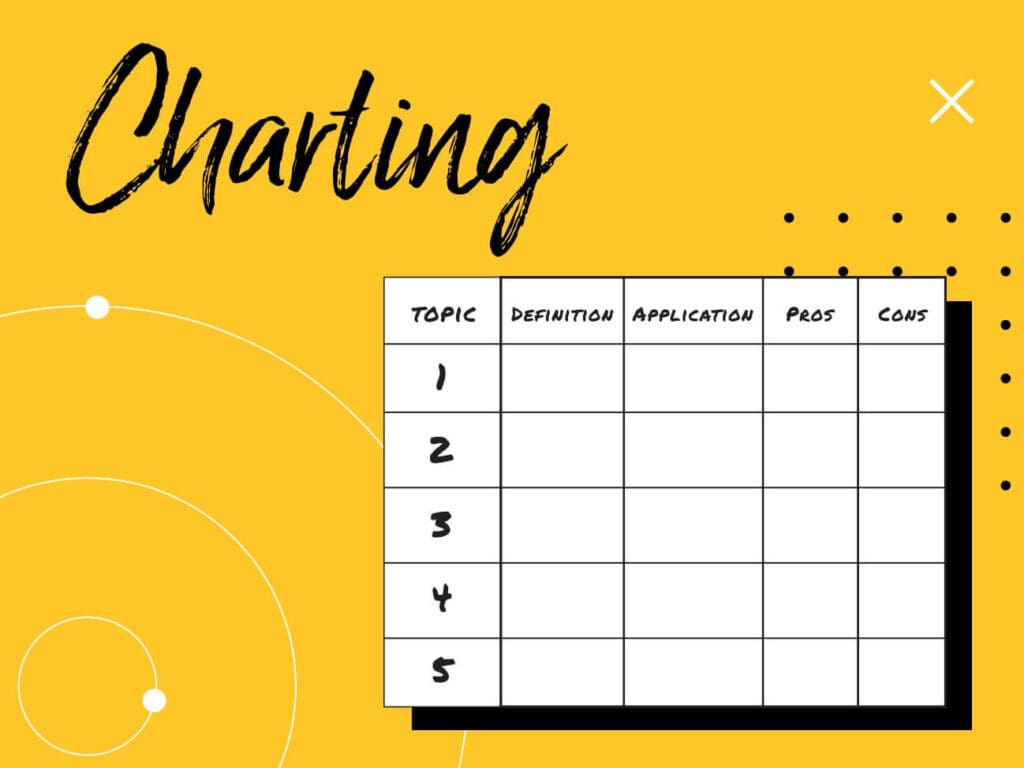
The charting and diagramming method is a structured approach to note-taking that leverages the power of visual organization to simplify the comparison and analysis of data, ideas, or concepts. This method is especially useful in subjects that demand an understanding of relationships between various elements, such as science, history, or literature, where comparative analysis is key.
Here’s a detailed guide on how to implement this note-taking style effectively:
- Identify comparison categories: Determine the categories or criteria you will use to compare different concepts. These categories will form the basis of your columns.
- Create a template: Once you have your categories, draw a chart with columns and rows on a sheet of paper or a digital note-taking tool. Label the top of each column with a category. The rows beneath these headings will be filled with information corresponding to each category for different concepts or entities you are comparing.
- Populate the chart: Start filling in the chart with information. Each row should correspond to a different concept or entity, and each cell within the row should contain information related to the column’s category.
- Analyze and synthesize: With your chart filled in, you can now more easily compare and contrast the different concepts based on the categories you’ve outlined. Look for patterns, similarities, and differences across the rows and columns.
- Review and adjust: After completing your initial chart, review the information for accuracy and completeness. You may find that you need to adjust your categories, add new ones, or refine the information provided for clarity and comprehensiveness.
By organizing information into columns and rows, the charting and diagramming method for comparative analysis offers a clear and efficient way to dissect complex topics.
The outlining method for structured thinkers
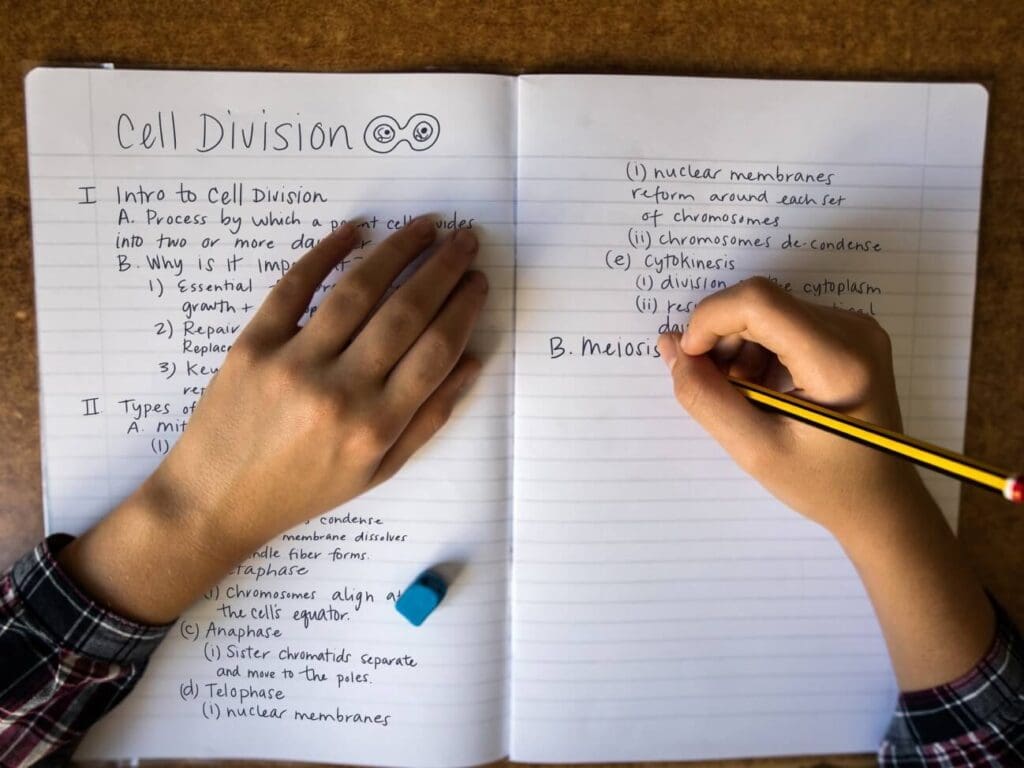
The outlining method is a powerful note-taking strategy that appeals to structured thinkers who prefer organization and clarity in their notes. By arranging information hierarchically, students can easily discern the structure of the lecture or reading material, distinguishing between main topics, subtopics, and supporting details. Here’s a step-by-step guide on how to master the outlining method:
- Prepare your page: Start with a clean sheet of paper or a new document on your digital note-taking app. Draw a margin on the left side of the page to leave space for later annotations or additional cues. Choose a clear and concise font if you’re using a digital tool, aiming for readability.
- Identify the main topics: Listen carefully to the lecture or read through the material to identify the main topics. These will serve as the primary headings in your outline. Write these main topics at the left margin of your page, leaving several lines of space under each one so you can add subtopics and details later.
- Add subtopics: Under each main topic, indent and write down subtopics. These are the secondary points that support or expand on the main topics. Make sure to listen for transitional phrases like “there are three main reasons” or “the second point is,” as these often signal a new subtopic.
- Detail with bullet points: Beneath each subtopic, use bullet points to list out specific details, examples, facts, or figures that support the subtopic. Each bullet point should provide evidence or elaboration for the subtopic it falls under. This hierarchical approach helps to organize complex information into manageable chunks.
- Use symbols and abbreviations: To keep your notes concise and quick to write, develop a system of symbols (such as arrows for causes and effects) and abbreviations that you can use consistently across your notes. This will speed up the note-taking process and make your outlines easier to refer back to during study sessions.
- Review and revise: After the lecture or reading session, review your outline to make sure it accurately represents the material covered. Fill in any gaps, clarify ambiguous points, and rearrange items if necessary to maintain logical progression.
Outlining is particularly beneficial for lectures or readings that have a clear structure. By visually organizing information, students can more easily understand and remember the material, making study sessions more productive and efficient.
Conclusion
In conclusion, helping your student explore different note-taking styles and techniques is crucial in finding what works best for their unique learning style. From handwritten notes to digital templates, the goal is to make the note-taking process as easy and efficient as possible, enabling your student to focus on the learning at hand. Whether through concept maps, the charting method, or a structured approach like the Cornell method, mastering the art of note-taking is a crucial skill for college prep as well as a stepping stone to academic success in the online classroom—and beyond.
Considering online school for your student?
Preparing for online school—and supporting your student on the journey—is easier than many parents/guardians think. ASU Prep Digital is a great option to consider if you want to explore the flexibility and personalization of an online school program.
At ASU Prep Digital we have a team dedicated to helping you navigate the enrollment process. We believe that every child and their family should be able to have an education that is unique and easily accessible.
ASU Prep Digital is an accredited online school program serving students in grades K–12, recognized as Arizona’s #1 Online School by Niche.com. Our unique teaching model supports students from the safety of their homes with the latest learning technologies and several layers of personalized instruction and coaching.
In addition, our program is a college prep option where online high school and university courses converge, preparing students for college acceptance and encouraging them to start earning credit toward college majors and careers.
We support districts in Arizona, while serving students and schools around the world. To learn more about ASU Prep Digital, please visit our website.
FAQ for Exploring different types of note-taking for online schooling
What is the most common note taking format?
The most common note-taking format is usually a combination of written notes and digital notes. Students can handwrite notes during live lectures or discussions, and then transfer them to a digital format for organization and easy access later on. However, there are many other formats that students can explore depending on their personal preferences and learning styles. Some popular note-taking methods include the Cornell method, concept mapping, and the outline method. Each one offers different ways to structure, organize, and review information effectively. It’s important for students to experiment with different formats to find what works best for them.
Which is the best note-taking method for different learning styles?
There are various note-taking methods that students can utilize to cater to their individual learning styles. Concept mapping is a great option for visual learners as it allows them to visually represent information in a diagram or flowchart format. This method helps with making connections between ideas and concepts, which can aid in understanding and retaining information.The Cornell method may work well for auditory learners as it encourages active listening and summarizing key points during lectures or discussions. This note-taking style also includes a section for reflections, which can be beneficial for those who learn best through self-reflection. Kinesthetic learners may benefit from using the charting method, where they can physically manipulate information by categorizing and organizing it into charts or tables. This hands-on approach helps with retaining information through muscle memory.
What note-taking strategies help students succeed in the classroom?
There are several strategies that students can use to improve their note-taking skills and ultimately succeed in the classroom. These strategies include the Cornell method, charting method, the mapping method, and the outline method.

